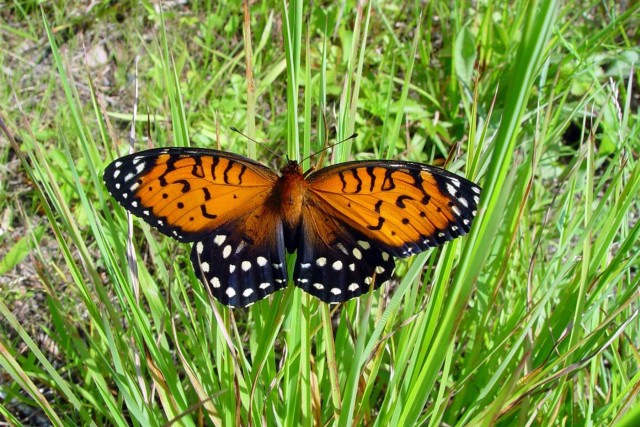<i>ABERDEEN PROVING GROUND, Md.--</I> The Army National Guard's <a href="http://www.dmva.state.pa.us/ftig/site/default.asp">Fort Indiantown Gap, Pa.,</a> trains 18,000 Pennsylvania guardsmen each year.
Soldiers aren't the only inhabitants at the installation, however; it turns out that there is no better place for the rare, regal fritillary butterfly.
Fort Indiantown Gap supports the largest regal fritillary population east of the Mississippi River. The regal fritillary butterfly, a Pennsylvania state species of concern, exists there because of the installation's grassy ranges, but those grassy ranges provide the Army's only live-fire, maneuver training site in the state.
Therefore, the installation's natural resources conservation team has the challenge of protecting this beautiful insect while providing the landscape in which National Guard Soldiers train for war. And, the team has met this natural resource challenge so successfully that it earned the Army's highest honor for environmental stewardship in 2007, the Secretary of the Army's Environmental Award for Natural Resources Conservation,
Every acre of the post has is needed in some way to support realistic training for National Guard Soldiers. "If we could we'd just set the grassland aside for the regal fritillary butterfly," said John Fronko, environmental program manager for the Pennsylvania Army National Guard, and leader of the natural resources conservation team. "Since land is a finite resource around here, though, we put our heads together and found a win-win solution for our Soldiers and our butterflies."
One solution is virtual mine fields. Fronko said the installation avoids mechanized training on 219 acres to preserve butterfly habitat by assigning some of that area as virtual 'mine fields' in training exercises. "That way we are still able to maintain realism and meet our training doctrine requirements at the same time," he said.
Another solution to keep the regal fritillary butterfly off of the endangered species list is transplanting a colony of the regal fritillary butterfly elsewhere in the state. The Gap's natural resources team is working with The Nature Conservancy to introduce the butterfly at the Gettysburg National Military Park.
In addition to the regal butterfly, the natural resources team manages 96 other state species of concern on 17,000 acres of the most biologically diverse ecosystems in the state, including forest, grassland, scrubland, savanna, and wetlands.
The secretary of the Army's environmental award will be conferred on the installation at a ceremony May 12 for its success both in protecting precious natural resources and in sustaining Fort Indiantown Gap's capability to train Soldiers.
<i>The <a href="http://aec.army.mil">U.S. Army Environmental Command</a> supports environmental programs that sustain Army training and operations while protecting the environment.</i>
<center><b>"Sustaining the Environment for a Secure Future."</b></center>
Related Links:
U.S. Army Environmental Command
Regal Fritillary Butterfly (Pennsylvania Department of Conservation and Natural Resources)


Social Sharing